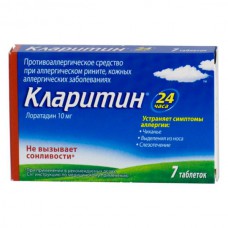Expiration date: 02/2026
Structure and Composition:
5 ml syrup contains Loratadine 5 mg
Excipients: citric acid artificial flavor (peach) glycerol propylene glycol sodium benzoate granular sucrose water (pH of 2.5-3.1)
in glass vials orange 60 or 120 ml in a carton box 1 bottle complete with measuring spoon.
1 tablet contains Loratadine 10 mg
Excipients: corn starch, lactose, magnesium stearate
in blister 7 or 10 tablets in a box 1 or 3 blisters.
Description pharmaceutical form:
Syrup: clear, colorless or slightly yellow syrup, not containing visible particles.
Tablets: white or almost white oval on one side of which there is a risk, as well as specifying the trademark "Cup and bulb" and the number "10". On the other side the tablet has a normal appearance.
Pharmacokinetics:
Rapidly absorbed from the gastrointestinal tract. Loratadine Cmax achieved after 1.3 hours, the main active metabolite (desloratadine) -. 2.5 hours Eating increases the Tmax of loratadine and desloratadine of about 1 hour, but the Cmax value is not changed. Cmax increased in elderly patients with chronic renal failure, or alcoholic liver disease.
Desloratadine is metabolized in the liver, with the participation of cytochrome R450ZA4 (CYP3A4) and to a lesser extent - R4502D6 (CYP2D6).
Return with urine and bile. T1 / 2 loratadine - 8.4 hours (3 to 20 hours), desloratadine - 28 hours (8.8 to 92 hours). T1 / 2 is increased in alcoholic liver injury (depending on the severity of the disease) and does not change in the presence of chronic renal insufficiency.
It passes through GEB passes into breast milk.
Hemodialysis has no effect on the pharmacokinetics of loratadine and desloratadine.
Description of the pharmacological actions:
Blocks peripheral gistaminove H1-receptor.
It has a rapid and long-lasting anti-allergic effect. Improvement usually noted within the first 30 minutes after ingestion. The antihistamine effect reaches a maximum after 8-12 hours after the onset of action and lasts more than 24 hours.
Loratadine does not penetrate the blood-brain barrier and does not affect the central nervous system, no anticholinergic and sedation (sleepiness), does not affect the speed of psychomotor reactions. Receiving Claritin does not cause QT interval prolongation of the ECG.
Testimony:
- seasonal (hay fever) and perennial allergic rhinitis and allergic conjunctivitis - symptomatic treatment of sneezing, itching, nasal mucosa, rhinorrhea, itching, and burning in the eyes, watery eyes
- chronic idiopathic urticaria
- skin diseases of allergic origin.
Contraindications:
- intolerance or hypersensitivity to the components within the drug
- up to 2 years
- during breastfeeding.
Carefully:
- pregnancy
- liver failure.
Application of pregnancy and breastfeeding:
Pregnancy is possible if the expected effect of therapy outweighs the potential risk to the fetus. At the time of treatment should stop breastfeeding (excreted in breast milk).
Side effect:
Adverse events were listed below, when used Claritin met with about the same frequency as that of placebo - & ge2%.
In adults, observed: headache, fatigue, dry mouth, drowsiness, gastrointestinal disorders (nausea, gastritis), allergic reactions such as rash (incidence to placebo level) In addition, there were rare reports of anaphylaxis, alopecia, disturbance of function liver, palpitations, tachycardia.
Children rarely observed: headache, nervousness or sedation. As in adults, the incidence of these events was on the same level as that of placebo.
Drug Interactions:
Ketoconazole, erythromycin, cimetidine increase the concentration of loratadine and its metabolite in plasma (no clinical significance, does not affect the ECG). It reinforces the effect of alcohol on the central nervous system.
Food intake does not affect the efficacy of the drug.
Dosage and administration:
Inside, regardless of meals. Adults (including the elderly) and children over 12 years - 10 mg (1 tab.) Or 10 ml (2 tsp) of syrup once a day 1.
Patients with impaired liver function or kidney failure initial dose - 10 mg (1 tab.) Or 10 ml (2 tsp) of syrup a day.
Children aged 2-12 years, the dose recommended to prescribe, depending on body weight:
- With a body weight less than 30 kg - 5 mg (. Table 1/2) or 5 ml (1 teaspoon) of syrup once a day 1
- With a body weight of 30 kg or more - 10 mg (. Table 1) or 10 mL (2 tsp) syrup 1 time per day.
Children under 3 years should receive the drug Claritin syrup.
Overdose:
Symptoms: drowsiness, tachycardia, headache.
Treatment: gastric lavage (preferably 0.9% sodium chloride solution), the appointment of adsorbents (activated charcoal milled with water), symptomatic therapy. Not removed by hemodialysis.






